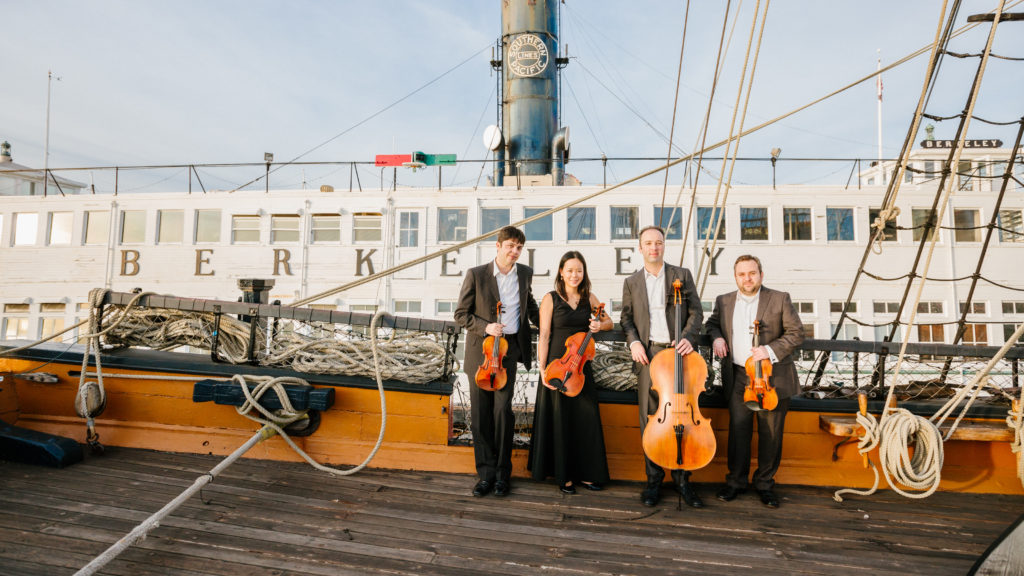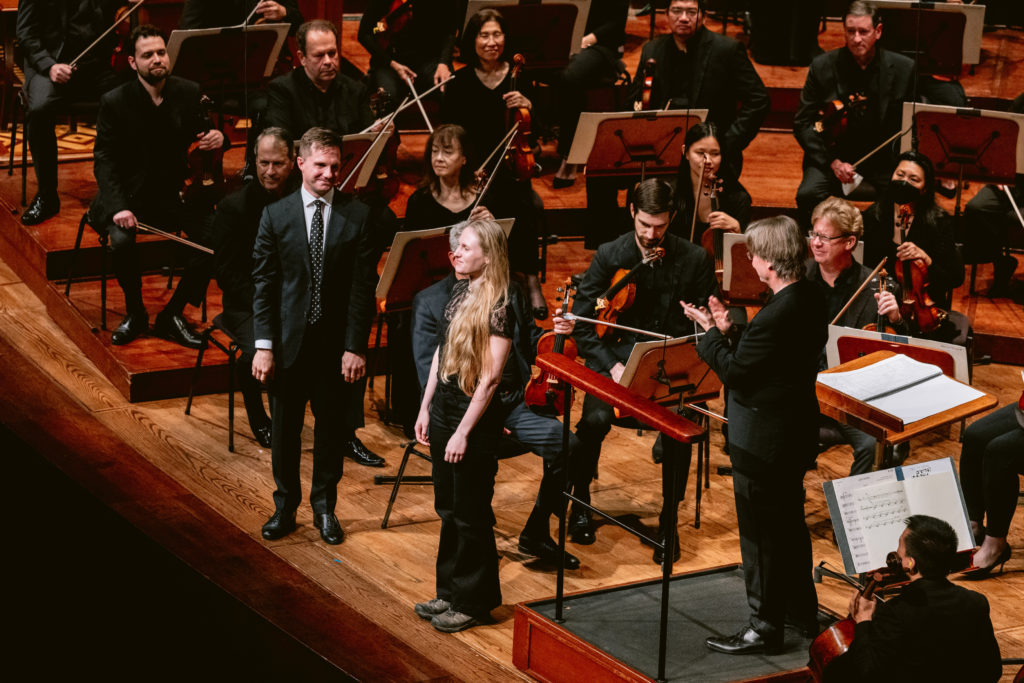Musical Adventures on Another Hadyn Voyage with the Hausmann Quartet
Completing its ninth season of Haydn Voyages: Music at the Maritime, San Diego’s Hausmann Quartet returned to the upper deck of the Berkeley on San Diego Bay to present another Sunday afternoon of riveting chamber music. This collaboration between San Diego’s premiere chamber ensemble and the Maritime Museum of San Diego continues to provide stellar concerts in this appealing, uniquely San Diego venue.

The Hausmann Quartet with the Berkeley in the background: Isaac Allen, Angela Choong, Alex Greenbaum, and Bram Goldstein [photo (c.) Samantha Zauscher]
Hausmann’s obvious purpose of the Haydn Voyages is to perform all of the string quartets written by Franz Joseph Haydn, the originator of this ubiquitous chamber music genre. The ensemble’s resident musicologist Prof. Derek Katz of the UC Santa Barbara music faculty noted in his opening remarks that this Sunday’s performance of Haydn’s F Minor Quartet, Op. 55, No. 2, would mark Hausmann’s 51st performance of the composer’s 59 string quartets.
Hausmann opened this concert with a dependably polished and insightful account of Haydn’s F Minor Quartet—known in some circles as the “Razor” Quartet—and closed their program with a robust but splendidly detailed performance of Beethoven’s valedictory quartet, his F Major String Quartet, Op. 135.
But for this audience member, the greatest excitement of Hausmann’s Sunday concert arrived with the lesser known works played between the Haydn and the Beethoven: the Third String Quartet of Czech composer Viktor Ullmann, written while held by the Nazis in the Theresienstadt concentration camp in 1943, and American composer Gabriella Smith’s 2015 string quartet titled Carrot Revolution.
A pupil of both Arnold Schoenberg and Alexander von Zemlinsky, Ullmann became a successful conductor and composer between the World Wars. After the German army occupied Czechoslovakia at the beginning of World War II, Ullmann was sent to Theresienstadt (the Czechs call the city Terezin), where the Nazis operated a “model” concentration camp especially for artists and performers who were encouraged to create art and perform plays and music. The camp’s cynical design was intended to deceive the visiting Swiss Red Cross observers who would conclude that the Jews Nazi’s were rounding up throughout Central Europe were actually well treated. Of course, when the course of the war turned in 1944, Ullmann and most of the other residents of Theresienstadt were shipped off to Auschwitz-Birkenau and murdered.
Ironically, most of the 20 compositions Ullmann wrote while held in Theresienstadt have survived, while much of the music he wrote as a conductor between the World Wars has not. His Third Quartet, Op. 46, a single movement work written in a rich, post-Romantic harmonic palette that is far from Schoenberg’s atonal gloom, is now programmed with some frequency.
First violinist Isaac Allen suavely shaped Ullmann’s long, searching opening theme that reminded me of Erich Korngold’s fluent Hollywood era style. In Ullmann’s second section filled with jaunty, angular motifs like an effervescent scherzo, Hausmann flexed its musical muscle with welcome panache. Violist Angela Choong provided a graceful solo transition to the quartet’s quieter, reflective section, followed by an exciting fugato, intense and episodic. Hausmann brought this quartet to a satisfying close as they revisited his opening theme, now robust and confident. Ullmann composed this work in the words of the 23rd Psalm “in the valley of the shadow of death,” but it stands as a hopeful testament to life and hope.
When I reviewed Gabriella Smith’s Carrot Revolution played by the Miró Quartet in the 2019 La Jolla SummerFest, I admired the composer’s craft, but I was not won over by her style. Last fall, however, I had the opportunity to hear the San Francisco Symphony under Esa-Pekka Salonen perform Gabriella Smith’s powerful organ symphony Breathing Forests, which gave me a deeper understanding of her style.

(l. to r.) Organist James McVinney, Gabriella Smith & Music Director Esa-Pekka Salonen on the stage of San Francisco’s Davies Symphony Hall in 2023 [photo (c.) Kristen Loken]
So I heard her Carrot Revolution with new ears, appreciating her iconoclastic deconstruction of the staid string quartet genre: acerbic fusillades of country fiddling and mischievous, percussive jazz riffs athletically tapped and pizzicatoed by cellist Alex Greenbaum while violinists Isaac Allen and Bram Goldstein added tunes in various popular styles to this eclectic jumble. After Carrot Revolution, the string quartet will never be the same, and I think that is a worthy achievement.
This concert was presented by the Hausmann Quartet at the Maritime Museum of San Diego on San Diego Bay on Sunday, November 24, 2024.

Ken Herman, a classically trained pianist and organist, has covered music for the San Diego Union, the Los Angeles Times’ San Diego Edition, and for sandiego.com. He has won numerous awards, including first place for Live Performance and Opera Reviews in the 2017, the 2018, and the 2019 Excellence in Journalism Awards competition held by the San Diego Press Club. A Chicago native, he came to San Diego to pursue a graduate degree and stayed.Read more…
